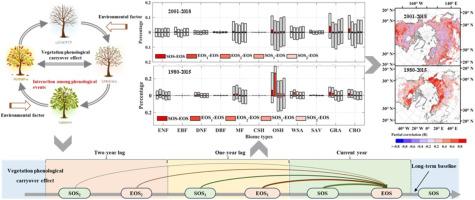当前位置:
X-MOL 学术
›
Agric. For. Meteorol.
›
论文详情
Our official English website, www.x-mol.net, welcomes your
feedback! (Note: you will need to create a separate account there.)
Influence of vegetation phenological carryover effects on plant autumn phenology under climate change
Agricultural and Forest Meteorology ( IF 5.6 ) Pub Date : 2024-10-28 , DOI: 10.1016/j.agrformet.2024.110284 Huanhuan YUAN, Jiabao YAN, Ying LIU, Jie PENG, Xiaoyue WANG
Agricultural and Forest Meteorology ( IF 5.6 ) Pub Date : 2024-10-28 , DOI: 10.1016/j.agrformet.2024.110284 Huanhuan YUAN, Jiabao YAN, Ying LIU, Jie PENG, Xiaoyue WANG

|
Vegetation phenological carryover effects refer to the influence of previous phenological events on the current or subsequent ones. These effects can modulate the responses of autumn phenology to climate change, but the magnitude and duration of this effect remain poorly understood. Therefore, we employed multiple remote sensing datasets from 1982 to 2018 in the Northern Hemisphere (> 30°N) and partial correlation to investigate the influence of the carryover effect and environmental factors on the end of the growing season (EOS) over time. The importance of the variables in the projection score was used to quantify their relative importance. Our results showed that the previous year's EOS had a robust positive impact on the EOS for 40.02 % of the study area during 1982–2015, which was mainly located in the northern 50°N region. In contrast, the start of the growing season (SOS) was the main contributor to the EOS during 2001–2018, mainly at 40°N-50°N and in northern Russia. The carryover effect persisted into the subsequent year, but its strength and positive impacts varied dramatically in the next year. Concurrently, the mean correlation coefficient between climate factors and EOS rose from 0.20 to 0.22. Notably, the correlation coefficient for frost day frequency increased significantly (P < 0.05) from 0.15 to 0.36, with its influence area expanding from 10.29 % to 11.85 % of the study area. Compared with climate factors, the phenological carryover effect was the dominant driver of the EOS for each vegetation type, accounting for 72.8 % and 44.23 % of the total pixels during 1982–2015 and 2001–2018, respectively. Our study reveals a cascade of ecological consequences that extend beyond the initial occurrence and emphasizes the interconnectedness of growth stages in the plant life cycle, providing valuable insights into the adaptability and vulnerability of plant communities.
中文翻译:

气候变化下植被物候遗留效应对植物秋季物候的影响
植被物候遗留效应是指先前物候事件对当前或后续物候事件的影响。这些效应可以调节秋季物候对气候变化的反应,但这种效应的大小和持续时间仍然知之甚少。因此,我们采用了 1982 年至 2018 年北半球 (> 30°N) 的多个遥感数据集和偏相关来研究遗留效应和环境因素对生长季结束 (EOS) 随时间推移的影响。预测分数中变量的重要性用于量化它们的相对重要性。我们的结果表明,在 1982-2015 年期间,前一年的 EOS 对 40.02% 的研究区域的 EOS 产生了强大的积极影响,该研究区域主要位于北部 50°N 地区。相比之下,生长季节开始 (SOS) 是 2001-2018 年 EOS 的主要贡献者,主要在 40°N-50°N 和俄罗斯北部。结转效应持续到下一年,但其强度和积极影响在下一年发生了巨大变化。同时,气候因素与 EOS 之间的平均相关系数从 0.20 上升到 0.22。值得注意的是,霜冻日频率的相关系数 (P < 0.05) 从 0.15 显著增加到 0.36,其影响区域从研究区域的 10.29 % 扩大到 11.85 %。与气候因子相比,物候遗留效应是各植被类型EOS的主要驱动因素,1982—2015年和2001—2018年分别占总像素的72.8%和44.23%。 我们的研究揭示了超越最初发生的一系列生态后果,并强调了植物生命周期中生长阶段的相互关联性,为植物群落的适应性和脆弱性提供了有价值的见解。
更新日期:2024-10-28
中文翻译:

气候变化下植被物候遗留效应对植物秋季物候的影响
植被物候遗留效应是指先前物候事件对当前或后续物候事件的影响。这些效应可以调节秋季物候对气候变化的反应,但这种效应的大小和持续时间仍然知之甚少。因此,我们采用了 1982 年至 2018 年北半球 (> 30°N) 的多个遥感数据集和偏相关来研究遗留效应和环境因素对生长季结束 (EOS) 随时间推移的影响。预测分数中变量的重要性用于量化它们的相对重要性。我们的结果表明,在 1982-2015 年期间,前一年的 EOS 对 40.02% 的研究区域的 EOS 产生了强大的积极影响,该研究区域主要位于北部 50°N 地区。相比之下,生长季节开始 (SOS) 是 2001-2018 年 EOS 的主要贡献者,主要在 40°N-50°N 和俄罗斯北部。结转效应持续到下一年,但其强度和积极影响在下一年发生了巨大变化。同时,气候因素与 EOS 之间的平均相关系数从 0.20 上升到 0.22。值得注意的是,霜冻日频率的相关系数 (P < 0.05) 从 0.15 显著增加到 0.36,其影响区域从研究区域的 10.29 % 扩大到 11.85 %。与气候因子相比,物候遗留效应是各植被类型EOS的主要驱动因素,1982—2015年和2001—2018年分别占总像素的72.8%和44.23%。 我们的研究揭示了超越最初发生的一系列生态后果,并强调了植物生命周期中生长阶段的相互关联性,为植物群落的适应性和脆弱性提供了有价值的见解。




















































 京公网安备 11010802027423号
京公网安备 11010802027423号